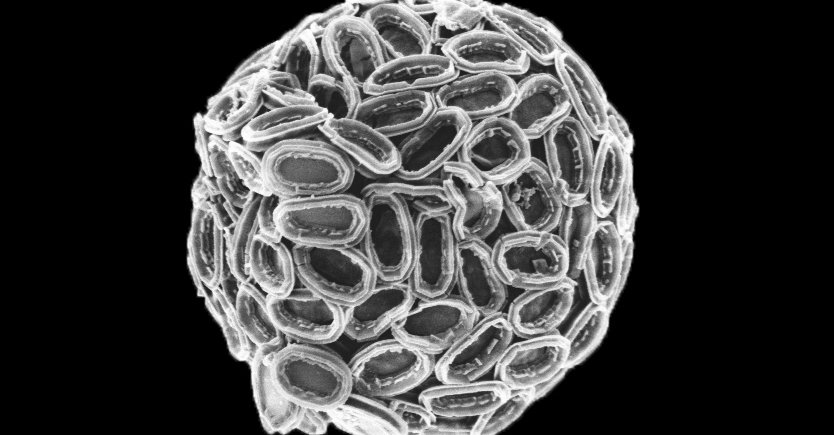(This is a summary of our German press release)
A study published in “Science” by Potsdam based scientists offers new insights into the mechanisms of mineralization in micro-organisms. The team led by André Scheffel from the Max Planck Institute of Colloids and Interfaces investigated marine microalgae, Pleurochrysis carterae, with shells containing calcite. The so-called coccoliths – tiny scales protecting the algae – are highly ordered arrangements of calcite crystals produced by the organisms. The study was accompanied by Richard Wirth from the GFZ German Research Centre for Geosciences who carried out analyses with the Transmission Electron Microscope TEM. According to the study, the localization of crystals within the coccoliths is determined by the interaction of nucleating macromolecules with the mineral phase. The scientists showed that, preceding nucleation, a specific interaction between soluble organic molecules and an organic backbone structure directs mineral components to specific sites. This strategy underlies the formation of coccoliths. The findings probably apply to all calcite forming organisms such as sea urchins and shells.
Publication:
Assaf Gal, Richard Wirth, Joachim Kopka, Peter Fratzl, Damien Faivre und André ScheffelMacromolecular recognition directs calcium ions to coccolith mineralization sites Sience, 5. August 2016; doi: 10.1126/science.aaf7889
MPI press release:
https://www.mpg.de/10678912/kalkalge-coccolith-biomineralisation?filter_order=L&research_topic=








![[Translate to English:] Torsten Sachs in front of a climate station on a field](/fileadmin/_processed_/3/9/csm__TorstenSachs_bearbeitet_GS_4a1365ef84.jpeg)

![[Translate to English:] left image flood at the Ahrtal: image from above, several houses are flooded; left image:: Heidi Kreibich;](/fileadmin/_processed_/4/4/csm_Bild2_9af0130e9f.png)



![[Translate to English:] Start der Vega Rakete](/fileadmin/_processed_/6/4/csm_20231201-kachel_Vega-VV23-launch_ESA-CNES-Arianespace_706716b68c.jpeg)









![[Translate to English:] Poster exhibition at the Brandenburg Hydrogen Day at the GFZ, some participants in the foreground](/fileadmin/_processed_/6/5/csm_Erster_Brandenburgischer_Wasserstofftag_GFZ_402fcec95e.jpeg)
![[Translate to English:] Group picture of the participants](/fileadmin/_processed_/9/4/csm_20231108_CAWa-Workshop-Tashkent_Gruppenbild_99ea779d8a.jpeg)

![[Translate to English:] [Translate to English:] Hörsaal](/fileadmin/_processed_/e/6/csm_H%C3%B6rsal_e21ac645fb.jpeg)


![[Translate to English:] The Delegations in the Historic Library on the Telegrafenberg. In the back there are from left to right, the Dutch Ambassador for Germany, Ronald van Roeden, the Dutch Minister for Education, Culture and Science, Robbert Dijkgraaf and the scientific director of the GFZ, Susanne Buiter.](/fileadmin/_processed_/d/b/csm_Kachel-2_9eba4b4212.jpeg)

